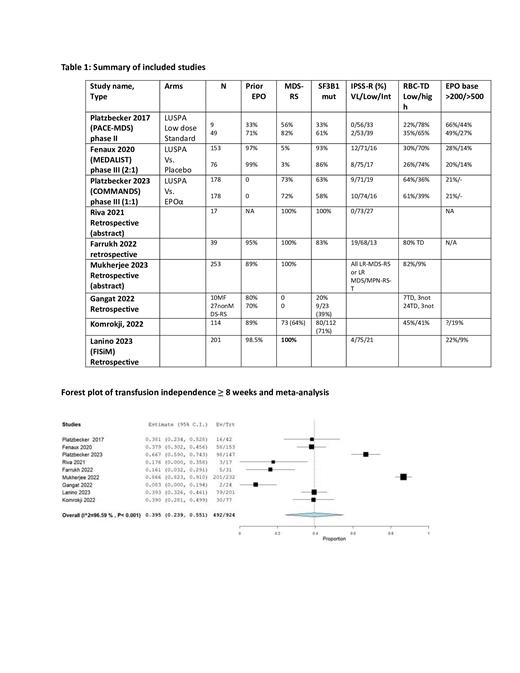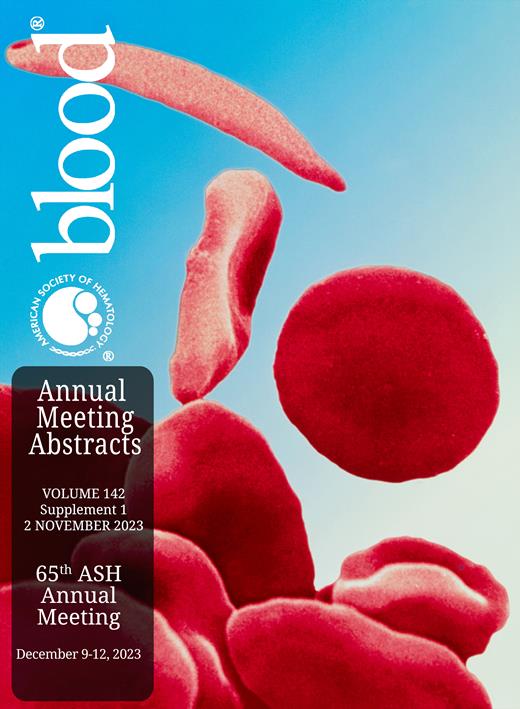BACKGROUND
Patients with anemia and lower-risk myelodysplastic syndromes (MDS) in whom erythropoiesis-stimulating agent therapy is not effective, inevitably become RBC-transfusion dependent, unless other lines of therapy are offered. Luspatercept, a recombinant fusion protein that binds transforming growth factor β superfamily ligands to reduce SMAD2 and SMAD3 signaling, has been FDA approved for use in MDS with ring sideroblasts (RS) and/or detection of an SF3B1 mutation. The efficacy of luspatercept in lower risk (LR) MDS (regardless of RS) patients has been evaluated in clinical and real-world (RWD) studies, suggesting conflicting data.
OBJECTIVES
This study aimed to conduct a systematic review and meta-analysis of clinical trials and RWD evidence to evaluate the efficacy of luspatercept among lower risk MDS patients.
METHODS
Prospective randomized controlled trials (RCTs) and phase II trials, retrospective cohort studies and case series of patients with MDS treated with single agent luspatercept were retrieved from PubMed, EMBASE and conference proceedings. References were screened until June 30 th 2023. Two reviewers appraised the quality of the studies and extracted data. Primary outcome was the rate of transfusion independence (for at least 8 weeks). Secondary outcomes included erythroid hematologic improvement (HI-e) rate and safety. Subgroup analysis was conducted for MDS-RS and SF3B1 mutation. Studies were critically appraised using Joanna-Briggs Institute checklists. All studies were included in the meta-analysis.
RESULTS
We screened 244 titles and eventually included 9 studies, conducted between 2013-2022, and including 839 MDS patients who were treated with luspatercept. Of them: 2 RCTs, one single arm phase 2, and 6 retrospective “real-world” (RWD) studies. Six were published in peer reviewed journals and three RWD studies published as abstracts. Median age of patients ranged between 68-75 years and 707/839 patients had MDS-RS. Three studies were of moderate-high quality (N= 389) and 6 were deemed moderate quality (N=450). Rates of transfusion independence for at least 8 weeks were highly variable ranged between 8-87% among all patients and between 42-87% among MDS-RS subgroup. The median duration of longest response ranged between 23.9-42 weeks. Rates of erythroid hematologic improvement (HI-e), ranged between 25-100%. Pooled estimate of achieving independence from red-cell transfusion for >= 8 weeks was 39.5% (95% CI 0.24, 0.55; I²=96.6%, p<0.001) by meta-analysis. Pooled estimate of HI-e was 54.4% (95% CI 0.44,0.65; I²=87.8%, p<0.001). The most common cause for drug discontinuation was lack or loss of response and disease progression.
CONCLUSION
The response rate to luspatercept is highly heterogenous among different studies. Overall, the response rate and duration in the RWD setting did not compare favorably with clinical trials. Of note, the vast majority of patients had MDS-RS and the role of luspatercept in the management of patients with MDS without RS is still unclear, even when data from several studies are pooled together. This study has many limitations arising from heterogeneity of patient characteristics and outcomes ascertainment. This highlights the need for standardized post-marketing studies of new drugs and the heterogeneity in RWD patient population.
Disclosures
Gurion:Novartis: Honoraria; Gilhead: Honoraria; Abbvie: Honoraria; Roche: Honoraria; Takeda: Honoraria; Medison: Honoraria. Raanani:Novartis: Consultancy, Research Funding; Pfizer: Consultancy, Research Funding; BMS: Consultancy, Research Funding; Janssen: Consultancy, Research Funding. Wolach:Medison: Honoraria; Abbvie: Consultancy, Honoraria, Research Funding; Astellas: Consultancy, Honoraria. Merkel:Abbvie: Honoraria.


